With Rare Publicity, Soviets Launch Spacecraft, 2 Cosmonauts
- Share via
MOSCOW — The Soviet Union launched Soyuz T-15 on Thursday with two cosmonauts on board headed toward a rendezvous with the space station Mir, departing from its customary secrecy by providing live television coverage of the event.
Except for missions involving foreign participation, the Soviet Union had never before permitted a live telecast of a space launch, although film has been shown on news programs.
Thursday’s flawless takeoff, from Baikonur Space Center in the Kazakhstan desert of Soviet central Asia at 4:33 a.m. PST, was seen on all channels of the Soviet television network and relayed to an Eastern European network. The launch also was televised in the United States.
Mixed Motives?
The decision to show the launching on live television may have been an example of Soviet leader Mikhail S. Gorbachev’s new policy of openness. Or it may have been intended to dramatize a Soviet success after the deaths of seven U.S. astronauts in the explosion of the space shuttle Challenger in January.
The Soyuz T-15, with cosmonauts Leonid Kizim and Vladimir Solovyov on board, rose smoothly into a slightly overcast sky as its booster rockets fired. As it headed for a linkup with Mir (Peace), the hub of a permanently manned space station that was placed in orbit without a crew Feb. 20, some small talk with the cosmonauts was heard, but the public heard nothing like the countdown that has become familiar in U.S. launches.
Record in 1984
The two men on board, Kizim, 45, and Solovyov, 40, broke the world space endurance record in 1984, staying aloft for 238 days. With them on that mission was cosmonaut Oleg Atkov.
A Soviet official said that the space station Mir was in its 345th orbit and ready to receive Soyuz T-15 at one of its docking ports. Also in orbit is the Soviet space lab Salyut 7. Mir is described as larger than the Salyut models, but its exact dimensions have not been made public.
According to Western analysts, the Soviet Union is clearly focusing its effort on permanent space stations in contrast to the American emphasis on the reusable shuttle program.
More to Read
Sign up for Essential California
The most important California stories and recommendations in your inbox every morning.
You may occasionally receive promotional content from the Los Angeles Times.












